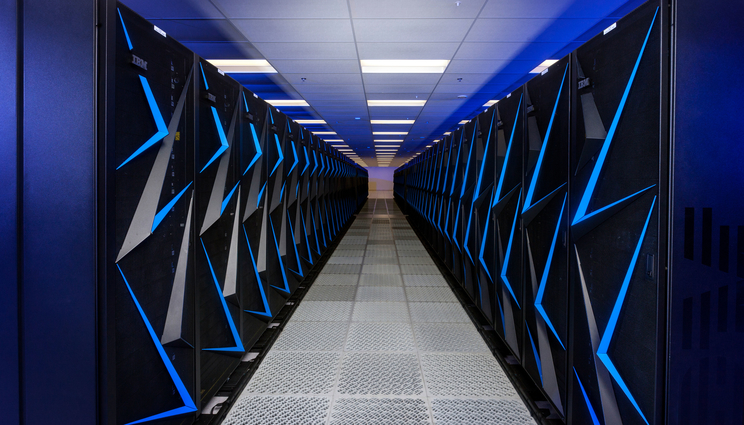LLNL, foundation seek to set up ALS consortium
 (Download Image)
LLNL and the Livermore Lab Foundation are joining hands to explore establishing a consortium that would leverage the Lab’s computing capabilities, such as the Sierra supercomputer shown above, to identify causal factors for amyotrophic lateral sclerosis, or Lou Gehrig’s disease.
(Download Image)
LLNL and the Livermore Lab Foundation are joining hands to explore establishing a consortium that would leverage the Lab’s computing capabilities, such as the Sierra supercomputer shown above, to identify causal factors for amyotrophic lateral sclerosis, or Lou Gehrig’s disease.
Lawrence Livermore National Laboratory (LLNL) and the Livermore Lab Foundation (LLF) are exploring the establishment of a consortium that would leverage the Lab’s computing capabilities to identify causal factors for amyotrophic lateral sclerosis (ALS), or Lou Gehrig’s disease.
Under a newly signed strategic partnership project agreement, the foundation will provide funds to the Laboratory to establish membership and scope for a consortium whose purpose is to leverage data analytics to identify causal factors, as well as potential biomarkers, for ALS.
Biomarkers are biological molecules found in blood, other body fluids or tissues that are a sign of a normal or abnormal process, or of a condition or disease. A biomarker may be used to see how well the body responds to a treatment for a disease or condition.
The envisioned ALS consortium could include top universities, clinical institutions and research organizations. LLNL capabilities that could be used in the ALS work are world-class supercomputers and computational modeling abilities, high-end data analytics at large scale and biosciences and bioengineering expertise to identify new biomarkers.
"One of the ways the foundation advances science is bringing together initiatives at different research organizations to work in complement on complex problems such as ALS," said Dona Crawford, Livermore Lab Foundation president. "By leveraging Lawrence Livermore’s unique capabilities, we aim to enable multidisciplinary teams to improve our understanding of the disease and, consequently, accelerate the development of new therapies and treatments."
Crawford, who served as associate director for LLNL’s Computing Directorate for 15 years prior to retiring in 2016, said the Laboratory is home to some of the world’s most powerful supercomputers and has experience applying high-performance computing to bioscience challenges.
"With intimate knowledge of the Laboratory’s experimental facilities and science and technology research programs, the foundation is well positioned to identify opportunities for collaborations that play to the partners’ strengths," Crawford said. "Collectively we can advance science in ways not possible as individual organizations."
Amy Gryshuk, the director of strategic engagements for the Lab’s Physical and Life Sciences Directorate, noted that "LLNL has unparalleled computing capabilities compared to almost anywhere in the world. With these capabilities, we’ve shown success working in the fields of oncology, drug discovery and traumatic brain injury.
"Our scientists have been able to work with complex datasets with the goal of developing new algorithms and tools for unique scientific challenges. These datasets are different from those on which our scientists normally work. They challenge us to improve our software and hardware, which provides further enhancements to our programmatic work," Gryshuk added.
At any given time, there are 20,000 Americans (between the ages of 40-70) affected with ALS, a progressive neurodegenerative disease that impacts the motor neurons from the brain to the spinal cord and, from there, the muscles in the body.
With the degeneration of the motor neurons, the brain is unable to initiate and control muscle movement and the muscle wastes away, impacting the ability to speak, eat, move and breathe.
LLNL researchers are working on three key life science collaborations with other national laboratories and the National Cancer Institute, a multi-institutional public-private partnership and with a medical research institute.
These collaborations are building capabilities for the life science research areas and the three computational platforms also have the potential to be applied to ALS.
Since 2016, Lab scientists have been working with researchers from the National Cancer Institute, Frederick National Laboratory for Cancer Research and Los Alamos, Argonne and Oak Ridge national laboratories through the "Joint Design of Advanced Computing Solutions for Cancer" (JDACS4C) pilot projects.
JDACS4C focuses on utilizing high-performance computing and advanced computational methods and algorithms to attain a greater understanding of cancer biology, pre-clinical screening, treatment challenges and risk identification.
Another collaboration, Accelerating Therapeutics for Opportunities in Medicine (ATOM), is a consortium established in 2017 to integrate high-performance computing, diverse biological data and emerging biotechnologies to create a pre-competitive platform for drug discovery (with an initial focus in oncology). In addition to LLNL, other ATOM members are GlaxoSmithKline, the University of California, San Francisco (UCSF) and Frederick National Laboratory for Cancer Research, a federally funded research and development center for the National Cancer Institute.
In the third project and since 2018, researchers from LLNL have joined with Lawrence Berkeley and Argonne national labs along with UCSF and other medical institutions to better understand traumatic brain injury. The project challenges and advances the Department of Energy’s capabilities in cognitive computing — coupling artificial intelligence and computing at scale.
Established in 2016, the LLF is a 501(c)(3) dedicated to the advancement of science and multidisciplinary research to "change the future" by accelerating the development of science and technology that benefits society.
The foundation provides a pathway for philanthropists to fund the development of new applications for existing and emerging science and technology at LLNL, such as applying the Lab's brain-mapping technologies — developed for the Department of Defense — to advance public health care. For more information about LLF, see the web.
Contact
 Stephen Wampler
Stephen Wampler
[email protected]
(925) 423-3107
Related Links
Livermore Lab Foundation“Lab will play key role in neuro conference”
“Public-private consortium aims to cut preclinical cancer drug discovery from six years to just one”
Tags
HPC, Simulation, and Data ScienceComputing
Physical and Life Sciences
Community Outreach
Featured Articles







